Grow tents and grow rooms have the same goal to provide a controlled environment for indoor cultivation. A grow tent is a self-contained indoor growing facility, providing a controlled environment for plants inside to thrive in, regardless of outdoor weather conditions or geographical location. On the other hand, a grow room is an indoor space particularly installed and managed to facilitate the growth of plants under controlled conditions, providing proper lighting, and better control of temperature and humidity for the plants being cultivated.
Grow tents and rooms differ in various aspects, including habitat differences, environmental differences, space differences, cost differences, plant differences, long-term vision and material differences. For instance, grow tents are less expensive than their counterparts, yet grow rooms are more flexible and provide more space for larger plants. Grow rooms are also ideal for experts, while grow tents are more suitable for beginner indoor growers.
Grow rooms require a larger initial investment and are complex to set up and maintain. Grow tents offer less space and are not as scalable as grow rooms, although they are energy-efficient, with fewer costs. Growers weigh the pros and cons to find a better solution for indoor vegetation.
Table of Contents
- What is a Grow Tent?
- What is a Grow Room?
- What Are the Differences Between Grow Tents and Grow Rooms?
- 1. Habitat Differences Between Grow Tent and Grow Room
- 2. Environmental Impact Differences Between Grow Tent and Grow Room
- 3. Space Differences Between Grow Tent and Grow Room
- 4. Cost Differences Between Grow Tent and Grow Room
- 5. Plant Preferences Differences Between Grow Tent and Grow Room
- 6. Long-term Vision Differences Between Grow Tent and Grow Room
- 7. Materials Differences Between Grow Tent and Grow Room
- What Are the Overall Pros and Cons When Comparing Grow Tents and Grow Rooms?
What is a Grow Tent?
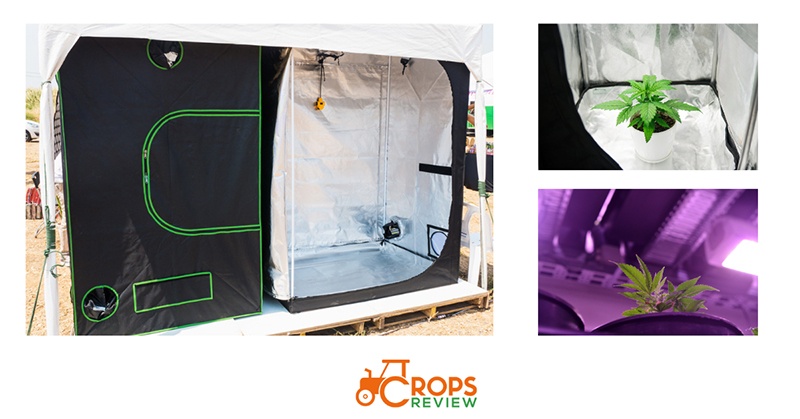
A grow tent is a portable, reusable grow room made of a sturdy canvas exterior and reflective interior material. They are designed to enable indoor gardening by creating an ideal environment for plants to grow in. The purpose of a grow tent is to control the indoor growing environment by insulating and sealing off the growing area from external elements such as weather conditions and pests.
Grow tents come in various sizes and often include features like adjustable intake and exhaust ports, which allow for the control of temperature and humidity levels. The reflective interior helps increase light intensity and distribution, ensuring that the plants get optimal light exposure. Grow tents also have built-in observation windows that allow you to check on your plants without disturbing the controlled environment.
Grow tents are popular among indoor gardeners because they allow for the cultivation of plants year-round, regardless of seasonal changes. They are also beneficial for growing exotic plants that would not usually survive in certain climates. Additionally, they provide an efficient way to manage water runoff and odor, making them a practical solution for indoor gardening.
In summary, a grow tent is a self-contained indoor growing space that provides a controlled environment for plants to thrive in, irrespective of outdoor weather conditions or geographical location.
What is a Grow Room?
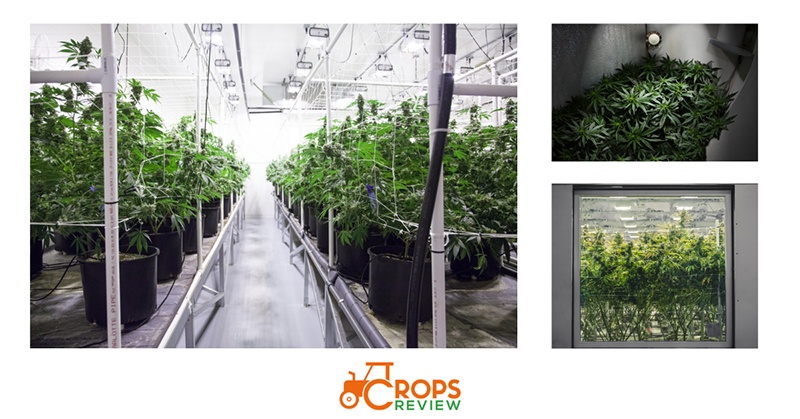
A grow room is a dedicated space designed for growing plants indoors under controlled conditions. It can be as simple as a single plant in a closet or as complex as a large-scale commercial operation.
In a grow room, all environmental conditions such as temperature, humidity, light intensity, and photoperiod are controlled to optimize plant growth. More advanced grow rooms even control CO2 levels and pH of the nutrient solution for hydroponic applications.
Grow rooms are often equipped with artificial lighting (like LED lights or high-pressure sodium lamps), ventilation systems to maintain air circulation and manage temperature, and sometimes irrigation systems for watering. The walls are typically covered with a reflective material to maximize light efficiency.
The purpose of a grow room is to provide an optimal environment for plant growth year-round, regardless of the external weather or climate. It allows gardeners to cultivate plants that wouldn’t normally grow in their region, or to grow plants out of season.
Grow rooms are commonly used for growing vegetables, herbs, and other plants indoors. They’re also popular in the cultivation of cannabis, where legal since controlling the environment leads to a higher yield and better quality product.
In summary, a grow room is an indoor space specifically set up and managed to facilitate the growth of plants under controlled conditions, providing optimal light, temperature, and humidity for the plants being cultivated.
What Are the Differences Between Grow Tents and Grow Rooms?
The key differences between grow tents and grow rooms include size and portability, cost, and environmental control.
Regarding size and portability, grow tents are generally smaller and more portable than grow rooms. They are easily assembled and disassembled, ideal for indoor gardeners with limited space or those who need to move their setup frequently. Grow rooms are usually larger and offer more customization. They can be any room in your house or even a custom-built structure, allowing for more plants and specialized setups.
Setting up a grow room is more expensive than a grow tent due to the cost of modifying a room and installing equipment. However, it also leads to higher yields due to more space and control over the growing conditions. Grow tents are typically less expensive than setting up a full-scale grow room. They come as a complete package with everything needed for growing plants indoors.
While grow tents provide a controlled environment, they don’t offer the same level of control as a dedicated grow room. For example, managing temperature and humidity is more challenging in a tent. A grow room offers superior control over the growing environment. It’s easier to manage factors like light, temperature, and humidity in a grow room compared to a grow tent.
Grow tents are a great option for beginners or those with limited space or budget. Grow rooms are more suited for serious indoor gardeners who want the most control over their growing conditions and the potential for larger yields.
The image below shows the differences between grow tents and grow rooms
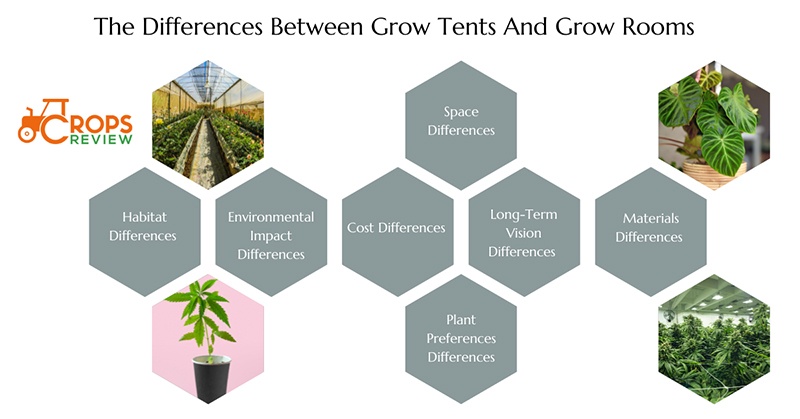
1. Habitat Differences Between Grow Tent and Grow Room
Grow tents and grow rooms serve the same purpose: to provide a controlled environment for indoor cultivation. However, their habitats differ in 4 main ways:
- Environment
- Setup
- Design
- Size Variability
A grow tent is a self-contained environment, offering an enclosed space with reflective interior lining to maximize light efficiency. A grow room is a dedicated space within your home or a separate structure designed specifically for indoor cultivation. It offers more room for larger or more numerous plants.
Being lightweight and easy to assemble, grow tents can be moved around or packed away when not in use. They are ideal for indoor growers without a dedicated space for growing plants. Unlike a grow tent, a grow room is typically a permanent setup. It requires more commitment, both in terms of space and cost.
Grow tents come pre-designed with ventilation and cable ports, ensuring proper air circulation and easy setup for lights and other equipment. A grow room allows for greater customization. You set up your lighting, ventilation, and irrigation systems exactly as you need them. customization is especially beneficial for large-scale or professional growers.
Grow tents come in various sizes, so indoor growers find one that fits their available space. Grow rooms are different rooms in your household, smaller or larger. You cannot choose their sizes as with grow tents.
2. Environmental Impact Differences Between Grow Tent and Grow Room
The environmental impact of grow tents and grow rooms vary based on factors like energy usage, insulation efficiency, and resource consumption.
A well-insulated grow tent can be energy efficient as it retains heat and light well due to its reflective interior. Energy efficiency results in lower electricity use for lighting and temperature control, reducing the carbon footprint. Grow rooms, especially larger ones, consume significant amounts of energy for lighting, temperature control, and ventilation. Such conditions have a greater environmental impact due to higher carbon emissions.
Grow tents, due to their smaller size, typically require less water than a full-scale grow room. Grow rooms, particularly large-scale ones, require more water than a grow tent, impacting water conservation efforts.
Grow tents are designed for reuse, reducing waste generated from frequently changing setups. However, they do not last as long as a permanent grow room structure, leading to waste if you must replace them frequently. A well-insulated grow room maintains temperature and humidity levels more efficiently, potentially reducing energy consumption. However, poor insulation leads to increased energy use.
3. Space Differences Between Grow Tent and Grow Room
The space available for plant cultivation is a significant difference between a grow tent vs. grow room, as growers know how many plants they cultivate inside the indoor growing facility. Generally, indoor growing rooms are more space-efficient for a more controllable environment and a significant amount of plants compared to tents.
Grow tents are generally more compact, and suitable for small spaces or apartments. They come in various sizes, but they are typically designed to fit into a corner of a room or a closet. Grow rooms are usually larger and accommodate more plants. A grow room is an entire room in your house or a custom-built structure.
The interior of a grow tent is lined with a reflective material to maximize light distribution. The interior allows for efficient use of space as plants get light from all directions. With a grow room, you have the flexibility to design your growing space as per your needs. You can set up multiple grow lights, and ventilation systems, and arrange your plants in a way that maximizes space usage.
Due to their smaller size, grow tents are not suitable for growing a large number of plants or larger plant varieties. Grow rooms are ideal for growing larger plants or cultivating multiple plants simultaneously due to their larger size.
A grow tent is perfect for hobbyists or those with limited space, while a grow room is more suited for serious growers who require an entire room for cultivation. Both options should be considered based on the individual needs of the grower.
4. Cost Differences Between Grow Tent and Grow Room
The cost differences between grow tents and grow rooms largely depend on their size, the quality of materials used, and the additional equipment required for growing plants.
Grow tents are generally more affordable. A small grow tent starts at around $100, with larger ones exceeding $300. There are also entry-level options available for under $150. Grow rooms, especially custom-built ones, are more expensive due to the cost of construction materials and labor. The cost varies greatly depending on the scale of your operation and the specifics of your setup. The cost for grow rooms is between $325 and $650 per square foot.
The setup costs for grow tents are typically lower as they come pre-designed with ventilation and cable ports. They don’t require major modifications to your home’s structure. The cost is $60-$70 per square foot. Setting up a grow room involves additional costs such as framing new walls, installing reflective material, and setting up ventilation, lighting, and irrigation systems. The cost is $75 per square foot.
Due to their smaller size, grow tents lead to lower utility costs for lighting, temperature control, and ventilation. Grow rooms, particularly larger ones, incur higher utility costs due to increased energy use for lighting, temperature control, and air circulation.
Grow tents are a more cost-effective solution, especially for beginners or those with a limited budget. The utility cost is around $45 per month. Grow rooms, while initially more costly, offer more customization and scalability, and are beneficial for large-scale or professional growers. The utility bill is approximately $89 per month.
5. Plant Preferences Differences Between Grow Tent and Grow Room
The choice between a grow tent and a grow room also depends on the type of plants you intend to grow, their size, and their specific environmental requirements.
Given their compact size, grow tents are typically better suited for smaller to medium-sized plants including herbs, leafy greens, peppers, and strawberries. A grow room, with its larger space, accommodates bigger plants or a larger quantity of plants such as tomatoes, melons, cucumbers, cannabis, and citrus tree.
Grow tents provide a highly controlled environment, ideal for plants that require specific temperatures, humidity, or light conditions. They are especially useful for sensitive or exotic plants that need precise conditions to thrive. Such plants include lettuce, spinach, radish, beets, bell pepper, ginger, onion, green beans, mushrooms, microgreens, cucumbers, cantaloupe or strawberries. Herbs like basil, rosemary, and oregano are also great for controlled environments of grow tents.
Grow rooms offer more flexibility in terms of layout and design. You create different zones for different types of plants, each with its microclimate. The best plants for growing rooms include peas, beans, okra, peppers, eggplant or tomatoes.
Due to space constraints, you are limited in the variety of plants you can grow at the same time in a grow tent. The most suitable plants are leafy greens, herbs, strawberries and peppers.
Grow rooms offer more flexibility in terms of layout and design. You create different zones for different types of plants, each with its microclimate. A microclimate of a plant includes temperature, humidity, wind and radiation to which the plant is exposed in a grow room. You grow a wider variety of plants simultaneously due to the larger space available. The most suitable plants are melons, dwarf citrus trees, tomatoes, cucumbers, and cannabis.
6. Long-term Vision Differences Between Grow Tent and Grow Room
Long-term vision differences between a grow tent and a grow room are primarily based on considerations such as scalability, flexibility, and investment.
Grow tents are typically not designed for scalability. If you wish to expand your cultivation, purchase additional tents or upgrade to a larger one. Design limits your long-term vision if you plan on significantly expanding your growing operation. Grow rooms are inherently more scalable. If you have a large space available, start with a smaller setup and gradually expand it as your operation grows. Grow rooms are more suitable for long-term visions that involve scaling up.
While grow tents provide excellent control over the growing environment, they offer less flexibility in terms of layout and design. More control affects your long-term plans if you intend to experiment with different growing techniques or plant varieties. With a grow room, you have the freedom to design your space as you wish. Flexibility allows for more experimentation with various layouts, growing methods, and plant types, which align with a long-term vision of continuous learning and improvement.
One of the advantages of grow tents is their lower initial cost. A grow tent is a good starting point if your long-term vision includes starting small and gradually investing more into your growing operation. Building a grow room often requires a larger initial investment. However, if your long-term vision involves creating a professional-grade growing operation, this investment could pay off in the long run.
Your long-term vision for your growing operation will determine whether a grow tent or a grow room is the best choice for you.
7. Materials Differences Between Grow Tent and Grow Room
The materials used in constructing a grow tent and a grow room have a significant impact on their functionality, cost, and overall performance.
The outer shell of a grow tent is typically made from thick, durable canvas. This material insulates the growing environment and blocks light leakage. A grow room is constructed using a variety of materials, depending on its location and design. Suitable materials include drywall, plywood, or concrete for the walls and ceilings.
Inside the grow tent, the walls are lined with a highly reflective material like Mylar. Reflective materials maximize light efficiency and ensure that the plants receive uniform light exposure. Similar to grow tents, grow rooms often feature walls covered with a reflective material. However, instead of Mylar, growers use white paint, reflective film, or even aluminum foil to bounce light around the room.
The frame of a grow tent is usually made of metal rods. Metal rods provide structural support and offer places to hang lights, fans, and other necessary equipment. The infrastructure of a grow room (like electrical wiring, plumbing, and ventilation ducts) is more complex than a grow tent. These are often built into the room’s structure and require professional installation.
Grow tents use pre-fabricated materials designed specifically for indoor gardening, while grow rooms incorporate a wider range of construction materials and require more complex infrastructure.
What Are the Overall Pros and Cons When Comparing Grow Tents and Grow Rooms?
When comparing a grow tent to a grow room, there are some main pros and cons to consider. The image below briefly describes the pros and cons of grow tents when compared to grow rooms
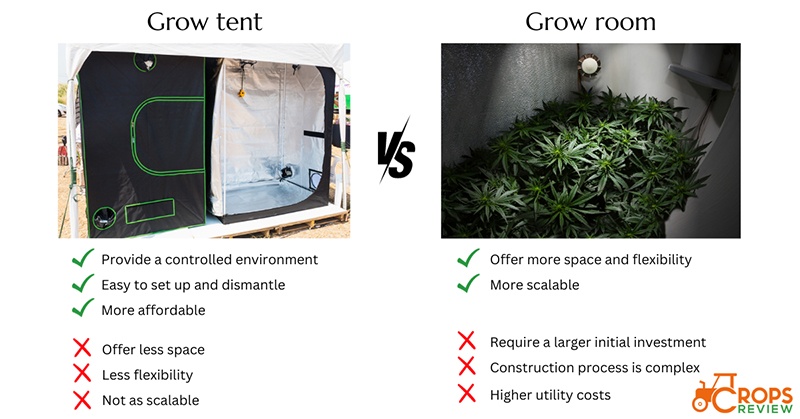
Starting with grow tents, one of the major advantages is that they provide a controlled environment. A controlled environment allows for precise regulation of temperature, humidity, and light conditions, ideal for growing delicate or exotic plants. Tents are also easy to set up and dismantle, making them a convenient choice for beginners or those with limited space. Additionally, grow tents are usually more affordable than setting up a full grow room, making them a cost-effective option for small-scale growers.
On the downside, grow tents offer less space, which limits the number and variety of plants you can grow. They also have less flexibility in terms of layout and design and are not as scalable if you plan on expanding your operation in the future.
Moving on to grow rooms, these offer more space and flexibility. You can design a grow room to your exact specifications, allowing for different zones for different types of plants or growth stages. Grow rooms are also more scalable, making them a better choice for large-scale operations or long-term plans.
However, grow rooms come with their own set of drawbacks. They often require a larger initial investment, both in terms of money and time. The construction process is complex and requires professional help. Additionally, creating optimal growing conditions (ventilation, humidity levels, temperature, grow lights) in a larger space is more challenging, leading to higher utility costs.
What Are the Advantages of Grow Room When Compared to Grow Tent?
Grow rooms have 5 advantages when compared to grow tents:
- Space: Grow rooms typically offer more space than grow tents, allowing for the cultivation of a larger number and variety of plants.
- Customization: With a grow room, you have the freedom to design your space exactly how you want it. You can customize everything from the layout to the lighting system, ventilation, and more.
- Scalability: Grow rooms are more scalable than grow tents, making them a better choice if you plan on expanding your operation in the future.
- Durability: Grow rooms, being permanent structures, are more durable than grow tents. They are less likely to suffer damage from environmental factors or regular wear and tear.
- Separation of growing stages: In a grow room, you have the option to create separate areas for different growth stages (like vegetation and flowering), which leads to better yields.
The image below describes 5 advantages of grow rooms when compared to grow tents
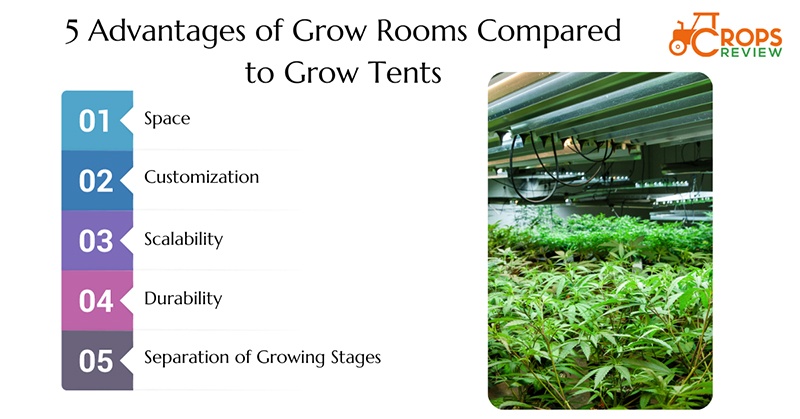
What Are the Advantages of Grow Tent When Compared to Grow Room?
Grow tents also come with 5 advantages when compared to grow rooms:
- Controlled environment: Grow tents provide an enclosed, controlled environment, allowing for precise regulation of temperature, humidity, and light conditions. They are ideal for growing delicate or exotic plants such as hibiscus, African violets, oxalis, etc.
- Easy setup: Tents are easy to set up and dismantle, making them a convenient choice for beginners or those with limited space.
- Cost-effective: Grow tents are usually more affordable than setting up a full grow room, making them a cost-effective option for small-scale growers.
- Portability: Grow tents are portable and can be moved around easily if needed. This is not the case with grow rooms which are fixed structures.
- Prevents pests and diseases: The enclosed design of grow tents prevents common pests and diseases from reaching your plants, including aphids, spider mites, fungus, root rot, mold ad mildew, leaf spot, etc.
